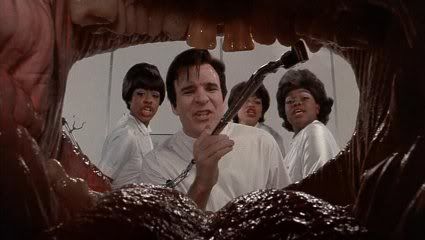
"Take a breath and look around. A lot of folks deserve to die." - AUDREY II, a carnivorous talking plant
Time for a moral self-inventory. What would you do for money? Fame? Love? All three at once? Think it over.
Let's say you lived in misery and poverty and were mocked and rejected on pretty much a daily basis. No one but no one respected you. Pity? Maybe. But respect? No. Let's also say that you were desperately in love with a co-worker who remained sadly out of your reach despite being just a few tantalizing feet away from you each day. Now let's further imagine that you stumbled across a miraculous solution to all your problems, a solution which unfortunately required you to kill a few people. Would you do it? Would you start murdering people? And would you commit further murders to cover up your earlier ones? After all, people are bound to start asking nosy questions...
Legendary B-movie screenwriter Charles B. Griffith seemed to think that, under those particular circumstances, a person of weak character might just become a killer, especially if the first few murders were more or less accidental and if the "victims" were largely unsympathetic. So in 1959, he wrote a cheap but effective little horror-comedy called A Bucket of Blood, in which a simpleminded schlemiel of a busboy (played by Dick Miller) stumbles first into killing and then into overnight success as a sculptor when he turns the corpses of his victims into "statues" by coating them with plaster and passing them off as works of art. The very next year, that film's director, Roger Corman, needed a script pronto in order to take advantage of some standing sets, so Griffith churned out a wackier variation on A Bucket of Blood, amping up the comedic and satiric elements, adding an absurd supernatural threat (a talking killer plant), and generally aiming for a freewheeling sketch-comedy/comic book feel, complete with silly names, throwaway gags, and wacky background signs. The resulting film, The Little Shop of Horrors, told the strange story of klutzy flower shop employee named Seymour (MST3K stalwart Jonathan Haze) whose apparent ticket out of Skid Row was a bloodthirsty talking plant, Audrey, Jr., who demanded human victims. In a way, the carnivorous plant of Little Shop was an even better metaphor for the vicissitudes of fame than the "statues" of Bucket of Blood. A plant, like fame, can either grow or wilt and must constantly be fed and tended to. In any event, Corman and Griffith's Little Shop had a shadowy half-life in the 1960s as the bottom half of a double bill with Mario Bava's Black Sunday but went on to be a perennial favorite at campuses and revival houses in the ensuing decades. Such was the film's enduring popularity that in 1982 -- twenty-two long years after its initial, ignoble release -- it became an off-Broadway musical by composer Alan Menken and lyricist Howard Ashman.
Continue reading Little Shop of Horrors, reviewed by Joe Blevins and Craig J. Clark.
